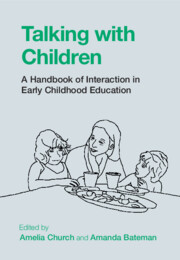Book contents
- Talking with Children
- Talking with Children
- Copyright page
- Dedication
- Contents
- Figures
- Tables
- Contributors
- Acknowledgements
- Notes on Transcription Conventions
- Introduction
- Part I Talk as Social Action
- Part II Pedagogy in Interaction
- 8 Literacy
- 9 Storytelling
- 10 Digital Technologies
- 11 Mathematics
- 12 Creativity
- 13 Multilingualism
- 14 Belonging
- Part III Interaction and Inclusion
- Index
- References
9 - Storytelling
from Part II - Pedagogy in Interaction
Published online by Cambridge University Press: 16 June 2022
- Talking with Children
- Talking with Children
- Copyright page
- Dedication
- Contents
- Figures
- Tables
- Contributors
- Acknowledgements
- Notes on Transcription Conventions
- Introduction
- Part I Talk as Social Action
- Part II Pedagogy in Interaction
- 8 Literacy
- 9 Storytelling
- 10 Digital Technologies
- 11 Mathematics
- 12 Creativity
- 13 Multilingualism
- 14 Belonging
- Part III Interaction and Inclusion
- Index
- References
Summary
Stimulating emergent literacy is one of the main goals of early childhood education. In order to accomplish this, the orientation to different aspects of literacy can be integrated into classroom interaction, as is shown in Chapter 10 of this Handbook. We demonstrate how early childhood educators can use children’s spontaneous attention to written text as a base for meaningful interaction by explicating their own acts of literacy and by talking with children whenever they read and write themselves. We also demonstrate how attention to literacy can be incorporated into shared reading interactions, by orienting the children to the structure of a story, the role of a book title and their understanding of the story. In addition, early childhood educators may organize meaningful activities in which children discuss literacy issues in peer interaction, while trying to write and to construct texts together. Illustrated by everyday examples, this chapter stresses the importance of eliciting meaningful teacher-child interaction and peer interaction around written text.
Keywords
- Type
- Chapter
- Information
- Talking with ChildrenA Handbook of Interaction in Early Childhood Education, pp. 185 - 203Publisher: Cambridge University PressPrint publication year: 2022
References
- 2
- Cited by

